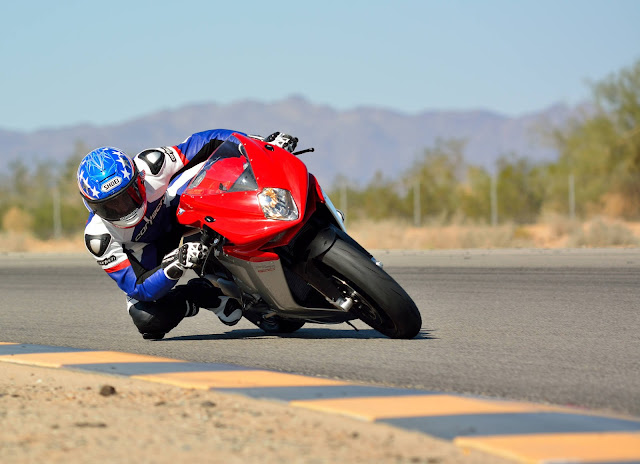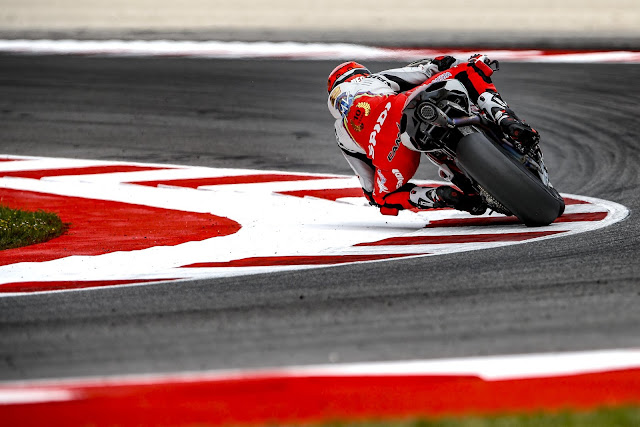MV Agusta F4 1000s
Only the optional silver-and-blue paint scheme and minor graphic details differentiated the sleek F4 lOOOS from its F4 750 relation - until its rider opened the throttle to send the 998cc MV hurtling forward with notably added force. Chassis layout was almost unchanged, too, although minor steering geometry revisions gave the more powerful newcomer a little extra stability.
Ufa MV Agusta claimed an official top speed of I86.9mph (300.7km/h) for the F4 I lOOOS, a figure apparently recorded during homologation testing at the Nardo Speed Bowl in southern Italy. Whether that was a realistic real-world figure or not, there was no doubt that the lOOOS was one seriously rapid motorbike, as well as a very beautiful one.
That was no surprise. After all, apart from its paintwork and graphics, the lOOOS looked almost identical to the F4 750 with which MV had made its dramatic return back in 1999. And beneath its gorgeously sculpted fairing was a bigger, 998cc four-cylinder engine that gave the reborn Italian marque an open-class contender for the first time.
The new motor retained the 750cc unit’s radial 16-valve layout and used many of its castings, but almost 70 per cent of the internal components were new. Many parts were lighter as well as being stronger, to cope with the additional output. The bigmotor produced a claimed I66bhp at 11,750rpm, within a few horsepower of its main Japanese rivals.
Like its bodywork, the lOOOS’s chassis was essentially that of the 750. The frame combined chrome-molybdenum steel tubes with cast-aluminium sections around the pivot for the single-sided swingarm. This bike’s upside-down Marzocchi forks were 50mm in diameter, like those of the limited- edition 750 SPR. and were angled half a degree less steeply at 24.5 degrees. The dry-weight figure was 422lb (l92kg), respectably light but slightly heavier than the lightest of the Japanese opposition.
That didn't prevent the MV from being fiercely competitive. At low revs the engine was unexceptional, but once into its stride the 1000S was a stunningly powerful and free-revving motorbike. The bigger motor was in a different league to the 750 as it kicked hard from 6000rpm, accompanied by a soulful sound as the radial-valve motor revved with delicious enthusiasm and smoothness, heading towards its limit at close to 13,000rpm.
Riders on a racetrack, in particular, also gained from its most innovative technical feature, its EBS or Engine Brake System, which delivered a small amount of fuel to one cylinder when the throttle was closed, preventing rear wheel lock-up under braking.
Sharp and stable
Handling was predictably superb. In tighter turns the F4 needed slightly more input than the 750, due to its less racy steering geometry, which added some stability to cope with the extra engine performance. Firm, well-damped Marzocchi forks and Sachs rear shock contributed to the bike’s taut feel. And the familiar blend of conventionally mounted six-pot Nissin calipers and 310mm discs gave sharp and controllable stopping.
It was predictable that the F4 1000S was a very rapid motorbike, but even some MV fans were pleasantly surprised when it fractionally outperformed all of its Japanese rivals in magazines’ initial back-to-back speed tests. And for all-round appeal, this most stylish and charismatic of superbikes was arguably the pick of the bunch.
It certainly had the speed, handling and refinement to give MV Agusta a serious open-class contender.
The 998cc radial 16-valve engine was held in MV's traditional frame, which combined steel tubes and cast-aluminium sections.
To the surprise of even some MV enthusiasts, the 1000S proved to be a straight-line match for even the fastest Japanese superbikes.
Beauty with Refinement: the New Generation F4
The F4 1000S and its successors including the F4 RR 312 - named after its claimed 194mph (312km/h) top speed - earned a reputation for fearsome performance, but eventually MV's design started to show its age. For 2010 the Italian marque, now owned by Harley-Davidson, launched a revamped F4 designed for refinement as much as speed. Beneath its reshaped fairing was a 998cc, 186bhp engine that was smoother than the previous unit.
Revised ergonomics, reduced weight and reworked suspension made the F4 more rider-friendly. Its success encouraged Claudio Castiglioni, whose firm had bought MV from Harley- Davidson, to unveil a 675cc three-cylinder derivative, the F3, for launch in 2011.
Specification MV Augusta F4 (2003)
- Engine Liquid-cooled dohc radial 16-valve four
- Capacity 998cc (76 x 55mm)
- Maximum power 166bhp at 11,750rpm
- Transmission Six-speed, chain final drive
- Frame Tubular steel and cast aluminium
- Suspension Telescopic front; single shock rear
- Brakes Twin discs front; disc rear
- Weight 422lb (192kg)
- Top speed 185mph (298km/h)























0 comments: